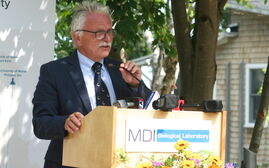
MDI Biological Lab explores use of ‘immortal’ cells in potential new medical treatments
 Courtesy / Mount Desert Island Biological Laboratory
Dustin Updike, an associate professor at Mount Desert Island Biological Laboratory, and his team are studying new pathways for tissue regeneration.
Courtesy / Mount Desert Island Biological Laboratory
Dustin Updike, an associate professor at Mount Desert Island Biological Laboratory, and his team are studying new pathways for tissue regeneration.
Immortal cells that can generate new tissue and fix damaged organs? Sounds like a sci-fi movie.
But researchers at Mount Desert Island Biological Laboratory in Bar Harbor are now looking at “germ” cells as a source of potential medical treatments, the lab said Wednesday in a news release. The cells, precursors to human sperm and eggs, are considered immortal because they are the only ones in the body with the potential to create an entirely new organism.
And they could offer a new approach to promoting tissue regeneration in organs damaged by disease or injury.
The research into germ cells contrasts with another approach in recent years, which focuses on stem cell therapies that reprogram the body’s own cells to replace damaged tissue. That’s a complicated process because it involves turning genes in the cell’s nucleus on and off.
But germ cells have stem cell-like qualities.
“By getting a handle on what makes germ cells totipotent, we can promote regeneration by unlocking the stem cell-like properties of other cell types,” said Dustin Updike, an associate professor at the lab.

The research shows that such cells can be reprogrammed by manipulating their composition and chemistry.
Updike and his team are using a tiny, soil-dwelling worm, called C. elegans, as a model for studying germ cells.
The scientists are working to identify proteins that determine whether a cell is destined to become a germ cell or another type, like those that comprise muscle, nerves or skin.
A better understanding of that process could lead to new approaches to promoting regeneration.
“The increase in chronic and degenerative diseases caused by the aging of the population is driving demand for new therapies,” the lab’s president, Hermann Haller, said in the release.“Dustin’s research on germ granules offers another route to repairing damaged tissues and organs in cases where therapeutic options are limited or non-existent, as well as an increased understanding of cancer.”
Because of the complexity of the cellular chemistry, research on proteins found in germ cells is often overlooked. But that’s rapidly changing, especially among pharmaceutical companies, as more scientists realize the impact and potential of such research, not only for regenerative medicine but also for an understanding of cancer development, Updike said.














0 Comments